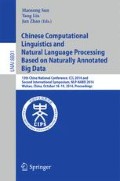Abstract
Ontology matching is one of the most important work to achieve the goal of the semantic web. To fulfill this task, element-level matching is an indispensable step to obtain the fundamental alignment. In element-level matching process, previous work generally utilizes WordNet to compute the semantic similarities among elements, but WordNet is limited by its coverage. In this paper, we introduce word embeddings to the field of ontology matching. We testified the superiority of word embeddings and presented a hybrid method to incorporate word embeddings into the computation of the semantic similarities among elements. We performed the experiments on the OAEI benchmark, conference track and real-world ontologies. The experimental results show that in element-level matching, word embeddings could achieve better performance than previous methods.
Access this chapter
Tax calculation will be finalised at checkout
Purchases are for personal use only
Preview
Unable to display preview. Download preview PDF.
References
Auer, S., Bizer, C., Kobilarov, G., Lehmann, J., Cyganiak, R., Ives, Z.G.: Dbpedia: A nucleus for a web of open data. In: Aberer, K., et al. (eds.) ISWC/ASWC 2007. LNCS, vol. 4825, pp. 722–735. Springer, Heidelberg (2007)
Bollacker, K., Evans, C., Paritosh, P., Sturge, T., Taylor, J.: Freebase: A collaboratively created graph database for structuring human knowledge. In: Proceedings of the 2008 ACM SIGMOD International Conference on Management of Data, pp. 1247–1250. ACM (2008)
Cheatham, M., Hitzler, P.: String similarity metrics for ontology alignment. In: Alani, H., et al. (eds.) ISWC 2013, Part II. LNCS, vol. 8219, pp. 294–309. Springer, Heidelberg (2013)
Choi, N., Song, I.Y., Han, H.: A survey on ontology mapping. ACM Sigmod Record 35(3), 34–41 (2006)
Collobert, R., Weston, J., Bottou, L., Karlen, M., Kavukcuoglu, K., Kuksa, P.: Natural language processing (almost) from scratch. The Journal of Machine Learning Research 12, 2493–2537 (2011)
Cruz, I.F., Antonelli, F.P., Stroe, C.: Agreementmaker: efficient matching for large real-world schemas and ontologies. Proceedings of the VLDB Endowment 2(2), 1586–1589 (2009)
Euzenat, J., Shvaiko, P., et al.: Ontology matching. Springer (2007)
Foltz, P.W.: Latent semantic analysis for text-based research. Behavior Research Methods, Instruments, & Computers 28(2), 197–202 (1996)
Glorot, X., Bordes, A., Bengio, Y.: Domain adaptation for large-scale sentiment classification: A deep learning approach. In: Proceedings of the 28th International Conference on Machine Learning (ICML 2011), pp. 513–520 (2011)
Gruber, T.R., et al.: A translation approach to portable ontology specifications. Knowledge Acquisition 5(2), 199–220 (1993)
Hoffart, J., Suchanek, F.M., Berberich, K., Weikum, G.: Yago2: a spatially and temporally enhanced knowledge base from wikipedia. Artificial Intelligence 194, 28–61 (2013)
Jean-Mary, Y.R., Shironoshita, E.P., Kabuka, M.R.: Ontology matching with semantic verification. Web Semantics: Science, Services and Agents on the World Wide Web 7(3), 235–251 (2009)
Jiang, J.J., Conrath, D.W.: Semantic similarity based on corpus statistics and lexical taxonomy. arXiv preprint cmp-lg/9709008 (1997)
Li, J., Tang, J., Li, Y., Luo, Q.: Rimom: A dynamic multistrategy ontology alignment framework. IEEE Transactions on Knowledge and Data Engineering 21(8), 1218–1232 (2009)
Li, Y., McLean, D., Bandar, Z.A., O’shea, J.D., Crockett, K.: Sentence similarity based on semantic nets and corpus statistics. IEEE Transactions on Knowledge and Data Engineering 18(8), 1138–1150 (2006)
Lin, D.: An information-theoretic definition of similarity. In: Proc. 15th International Conf. on Machine Learning, vol. 98, pp. 296–304 (1998)
Lin, F., Sandkuhl, K.: A survey of exploiting wordnet in ontology matching. In: Bramer, M. (ed.) Artificial Intelligence in Theory and Practice II. IFIP, vol. 276, pp. 341–350. Springer, Heidelberg (2008)
Mikolov, T., Sutskever, I., Chen, K., Corrado, G., Dean, J.: Distributed representations of words and phrases and their compositionality. In: Proceedings of NIPS (2013)
Mikolov, T., Zweig, G.: Context dependent recurrent neural network language model. In: SLT, pp. 234–239 (2012)
Miller, G.A.: Wordnet: a lexical database for English. Communications of the ACM 38(11), 39–41 (1995)
Ngo, D., Bellahsene, Z., Todorov, K.: Opening the black box of ontology matching. In: Cimiano, P., Corcho, O., Presutti, V., Hollink, L., Rudolph, S. (eds.) ESWC 2013. LNCS, vol. 7882, pp. 16–30. Springer, Heidelberg (2013)
Pedersen, T., Patwardhan, S., Michelizzi, J.: Wordnet:: Similarity: Measuring the relatedness of concepts. Demonstration Papers at HLT-NAACL 2004, pp. 38–41. Association for Computational Linguistics (2004)
Shvaiko, P., Euzenat, J.: Ontology matching: State of the art and future challenges. IEEE Transactions on Knowledge and Data Engineering, 158–176 (2013)
Socher, R., Lin, C.C., Manning, C., Ng, A.Y.: Parsing natural scenes and natural language with recursive neural networks. In: Proceedings of the 28th International Conference on Machine Learning (ICML 2011), pp. 129–136 (2011)
Stoilos, G., Stamou, G., Kollias, S.D.: A string metric for ontology alignment. In: Gil, Y., Motta, E., Benjamins, V.R., Musen, M.A. (eds.) ISWC 2005. LNCS, vol. 3729, pp. 624–637. Springer, Heidelberg (2005)
Turian, J., Ratinov, L., Bengio, Y.: Word representations: a simple and general method for semi-supervised learning. In: Proceedings of the 48th Annual Meeting of the Association for Computational Linguistics, pp. 384–394. Association for Computational Linguistics (2010)
Wu, Z., Palmer, M.: Verbs semantics and lexical selection. In: Proceedings of the 32nd Annual Meeting on Association for Computational Linguistics, pp. 133–138. Association for Computational Linguistics (1994)
Author information
Authors and Affiliations
Editor information
Editors and Affiliations
Rights and permissions
Copyright information
© 2014 Springer International Publishing Switzerland
About this paper
Cite this paper
Zhang, Y. et al. (2014). Ontology Matching with Word Embeddings. In: Sun, M., Liu, Y., Zhao, J. (eds) Chinese Computational Linguistics and Natural Language Processing Based on Naturally Annotated Big Data. NLP-NABD CCL 2014 2014. Lecture Notes in Computer Science(), vol 8801. Springer, Cham. https://doi.org/10.1007/978-3-319-12277-9_4
Download citation
DOI: https://doi.org/10.1007/978-3-319-12277-9_4
Publisher Name: Springer, Cham
Print ISBN: 978-3-319-12276-2
Online ISBN: 978-3-319-12277-9
eBook Packages: Computer ScienceComputer Science (R0)

